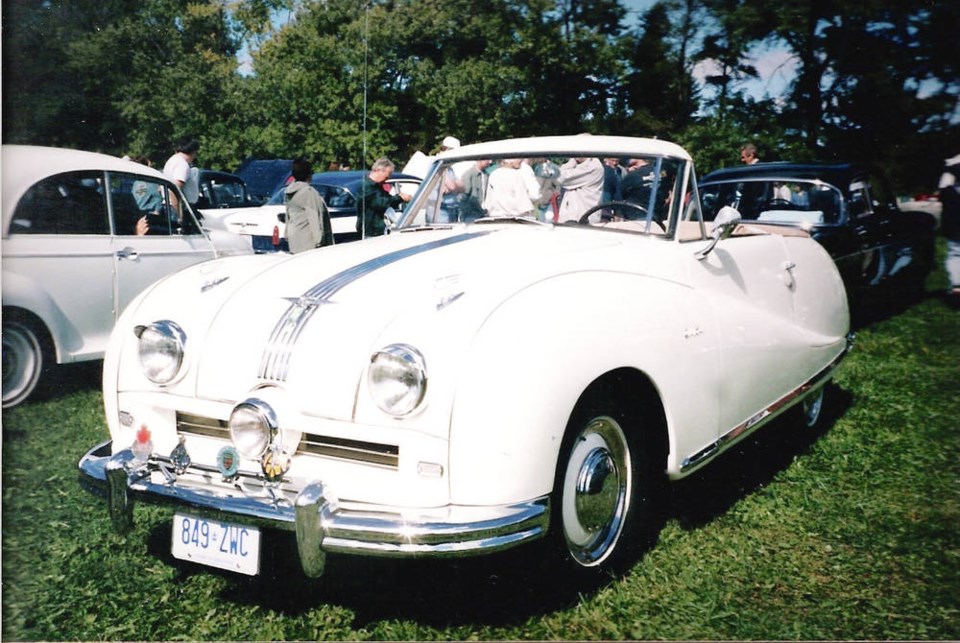When imported cars began arriving in North America after the Second World War, the English Austin nameplate initially became the best known. During the late 1940s and early ’50s the small Austin A40 was the top selling imported car, before Volkswagen started taking over.
The English Austin was already familiar in the United States and to a lesser extent sa���ʴ�ý. An Americanized version of the tiny Austin Seven had been manufactured in Pennsylvania in the 1930s. It was marketed first as the American Austin, and after re-organization in 1935, as the American Bantam. It was too small to gain much popularity in a large-car market.
There was also a big luxurious Austin built by the Austin Automobile Co., an American company in Grand Rapids, Michigan from 1903 to 1920. It was unrelated to the English Austin and is largely forgotten.
When the Austin Motor Co. of England introduced its new postwar A40 model in 1947 as the four-door Devon and two-door Dorset it replaced the pre-war designed Eight, Ten and Twelve models.
Britain was hungry for hard currency and rewarded successful exporting companies with extra steel allocations. Austin benefitted and the A40 was effectively marketed in North American, especially sa���ʴ�ý. They were helped by the pent-up demand for cars caused by the war-time shutdown in auto production.
Although the A40 was a pleasant little car admirably suitable for England, it was less compatible with the vast distances of North America. Nevertheless it sold well enough that Austin decided it could do even better with a larger, sportier car specifically designed for North America.
The result was the 1949 A90 Atlantic which came first as a convertible with manual or electro-hydraulic power top, joined later by a sport sedan.
While not resembling any particular American car, its faintly Art Deco design was clearly influenced by them. It was attractively styled with a horizontal bar grille, not Austin’s traditional upright design, and the hood and deck lid carried Pontiac-like chromed stripes.
There was a “Cyclops eye” driving lamp in the middle of the grille, a la Rover, and the headlamps were located inboard above the grille. A flying-A Austin hood ornament was mounted on each front fender.
The front fenders were somewhat bulbous with the fender line sweeping back and down to the rear bumper. It had full rear-wheel fender skirts and the steep drop-off of this fender line gave the impression that the A90’s tail was riding a little higher than it should.
The interior was nicely finished in leather and the column-shifted, four-speed transmission allowed three (friendly) people to ride in the front. The cosy rear seat would accommodate two more.
Power came from a bored out version of the A70 Hampshire sedan engine displacing 2.6 litre (2,660 cc; 162 cu in.).This 88 horsepower overhead valve in-line four with two SU carburetors accelerated the 1,270 kg (2,800 lb) A90 to 60 mph (97 km/h) in 16.6 seconds, and reached a top speed in excess of 90 mph (145 km/h) according to The Motor. While not tire-burning performance it was quite adequate and compared favourably with some contemporary North American cars.
The chassis was conventional with front A-arms and coil springs and rear leaf springs on a beam axle. Its wheelbase was 96 in. (2,438 mm) and length was 177 in.(4496 mm ). Brakes were initially hydraulic front and mechanical rear but became full hydraulic for 1951.
When the A90 Atlantic arrived in North America it made an auspicious entrance when one was taken to the Indianapolis Speedway in April, 1949 where it broke 63 AAA stock car speed records. In terrible rainy weather it covered 11,850 miles (19,080 km ) in seven days, averaging 70.54 mph (113 km/h), including a flying five miles at 98.58 mph (159 km/h).
With attractive styling, good performance and those prestigious speed records the Austin A90 Atlantic should have taken North America by storm. Unfortunately for Austin, it didn’t.
One problem was an initial price in the $3,000 range. For that money buyers could have a choice of cars like a Buick or Mercury convertible which were bigger and more impressive. The price was soon reduced by $1,000 but it didn’t help much.
Although built to attract North Americans the A90 Atlantic never really caught on. It was continued until 1952, the year Austin and Morris merged to form the British Motor Corp. Total Atlantic production during its 1949 to ‘52 model run was approximately 8,000.
While the A90 Atlantic failed to bring the hoped-for hard currency to Britain, its engine, transmission and suspension proved robust enough to go on to much greater fame than the A90 ever achieved. They formed the basis for the popular Austin-Healey 100/4 sports car which arrived to great acclaim in 1953.



